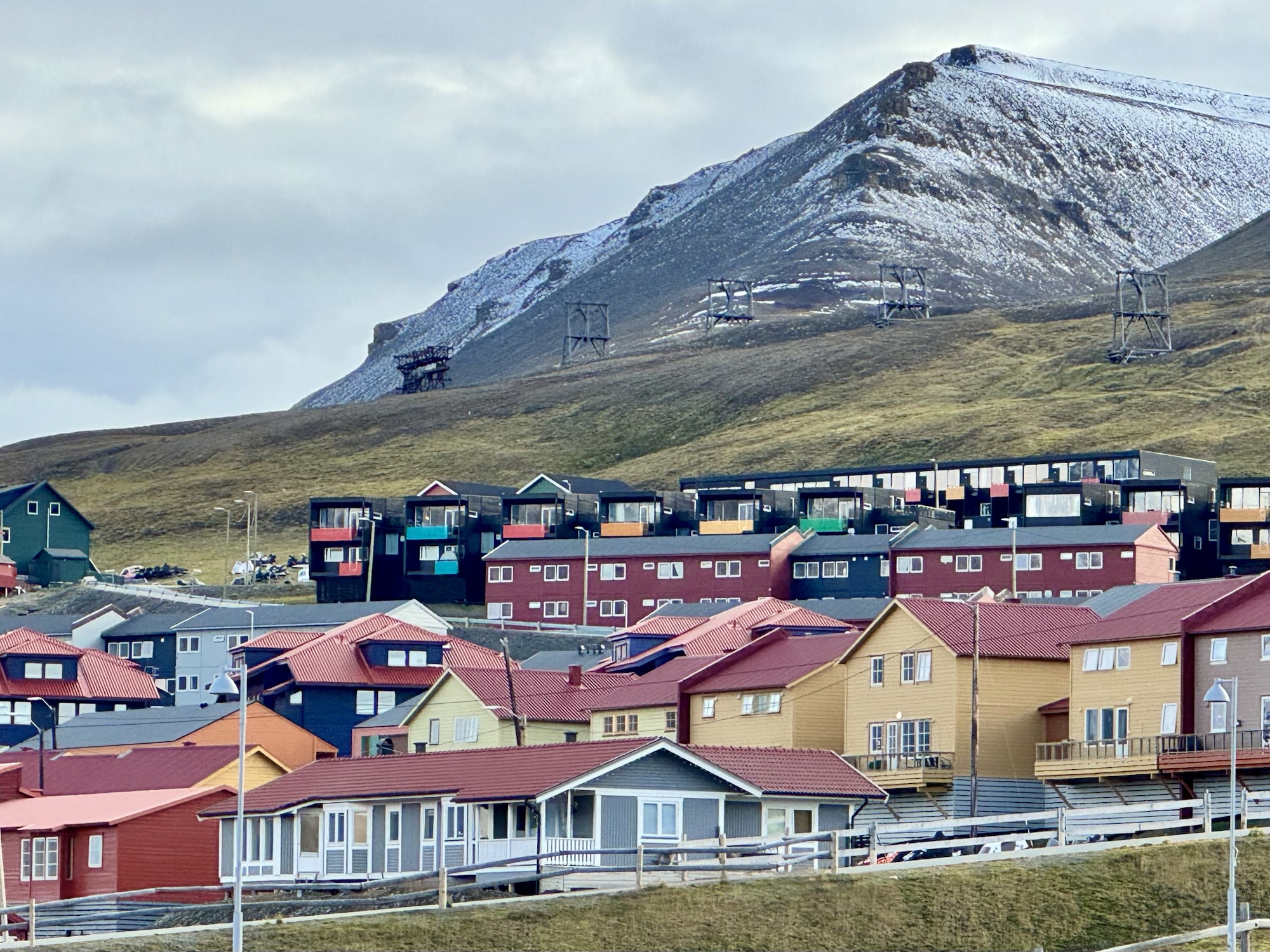
Tuesday, September 16. After a 36 hour open ocean crossing we approached Svalbard Island. We would visit two ports of call, the first being Longyearbyen, the northernmost town in the world that has a population of more than 1000.
Our rather pedestrian (standard but small) cabin is located on the 8th deck. Deck 9, the observation deck, is a short stroll down the corridor and up some stairs. I threw on clothes and a light sweater and ascended to that deck. I was in for a shock! The weather of the last few days had been like late Fall in Kansas City. What I emerged into was the depth of Winter. Cold, driving wind, and snow on the surrounding shores. So much for light sweaters. Today would be full on foul weather outerwear.











Longyearbyen hosts a population of 2,600 (including @500 children) and proudly notes that its residence hail from over 50 countries. It’s an industrial town with an economy based on fishing, arctic research, adventure tourism, and until earlier this year on coal mining.





The Svalbard Longyearbyen Global Seed Vault is located here, but more on that later.
The town was founded in 1907 by John Longyear, of Michigan, USA, owner of the Arctic Coal Company. The town was almost completely destroyed by the Nazis in 1943 and has since been rebuilt as a vibrant modern community.
Today Longyearbyen features an airport, hospital, weekly newspaper, and university extension, in addition to various commercial enterprises.
Interestingly, it does not feature a cemetery. It was found in the 1950s that the permafrost did not allow for the decomposition of the dead. There was fear that biological organisms might remain alive and emerge with the bodies which occasionally surfaced over time due to frost heave. 44 bodies were removed and relocated to the mainland. Thereafter the dearly departed have truly been departed south.
Longyearbyen is ARCTIC! The midnight sun lasts 128 days and polar night is 111 days long. Global climate change/warming impacts Longyearbyen and Svalbard Island more than every other part of the globe.
Humanity’s Lifeboat. The Seed Vault of Longyearbyen.
I’m 73 years old. Those of my generation may recall that in our childhood the elephants, rhinoceroses, hippopotami, great cats, the great apes, whales, and walruses… seemed of an inexhaustible numbers. Sadly, extinction for each of these is a very real concern today.
Science has identified 5 great extinction events that have occurred over the Earth’s history. Science has also identified a 6th extinction, The Holocene, also called The Anthropocene Extinction. Flora and Fauna species are disappearing at an unprecedented rate. Causes and blame are topics for a different discussion.
Since the early 20th century, there have been significant efforts to preserve plant biodiversity for future generations. Among these:
The Institute of Plant Genetic Resources in Saint Petersburg, Russia was started in 1924. It survived the 28 month siege of Leningrad in World War II because several botanists chose starvation rather than to eat the seed collections and potatoes.
The Millennium Seed Bank near London, UK, was established in 1996 and is the largest seed bank in the world. It is already home to over 2 1/2 billion seeds representing nearly 40,000 different plant species.
The 12,000 square foot Svalbard-Longyearbyen Global Seed Vault opened in 2008.

As of February 2025 it has received seed samples from 123 genebanks in 85 countries around the world,
Photo: Michael Major for Crop Trust

The vault is located hundreds of feet underground, deep in the Arctic permafrost, and within 3 foot thick concrete and steel walls. It is designed to withstand earthquakes, nuclear war, and the ravages of time. Temperatures within are sub-freezing, dry, and ideal for long term seed preservation. The purpose of this vault is the preservation of important food crop species. Signatory countries and organizations archive the seeds of their food crops here. Current holdings include approximately 20 million seeds representing over 13,000 years of agricultural history and 1/3 of the most important food crop varieties in the world.

Most recently Syria withdrew some of its seed stocks in an effort to reestablish agriculture in its post war era.
Seed vaults in general, and Longyearbyen’s in particular, may indeed be humanities lifeboat.
Peace Everyone. Pete
PS. Yesterday we secured an upgrade to our cabin. We can no longer call our accommodations “pedestrian“. We can no long call it a “cabin”.


GARRY CLIFFORD says:
You gotta be one tough SOAB to live in that part of the world! Harsh and outstandingly beautiful, but man that would be tough!
Pete Schloss says:
Yes to that! Imagine growing up there as a child, there are 500 of them. The final stop north is next and even more stark. The coal company’s doctor kept a straitjacket!!
Pam Roberts says:
Impressive! We think our winters here in certain areas of the states can be harsh, but living in the conditions in northern Norway is no comparison. One would have to be strong willed to survive those conditions. Thanks, Pete, for sharing your adventures.
Pete Schloss says:
I’m glad you are enjoying this Pam!